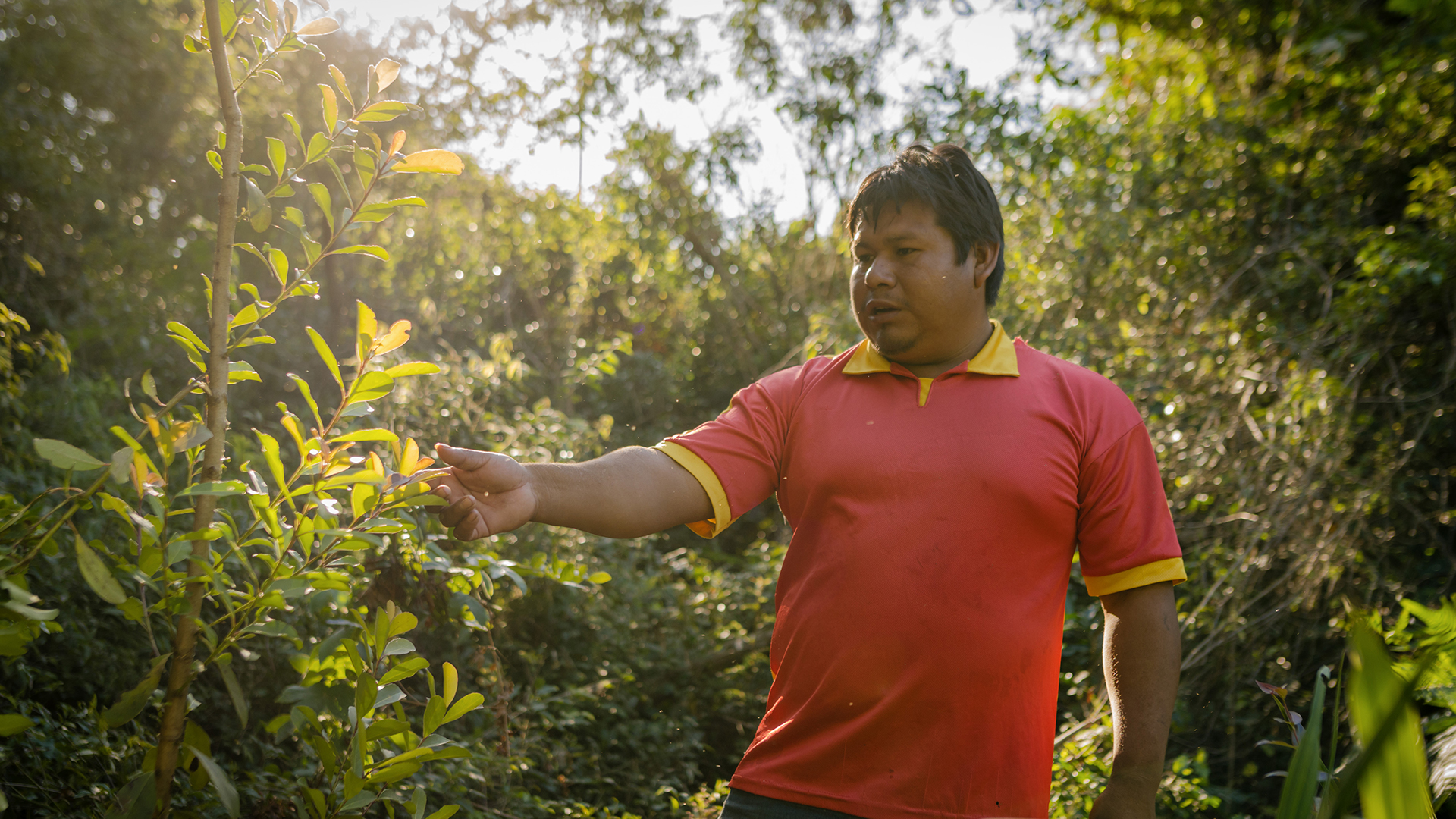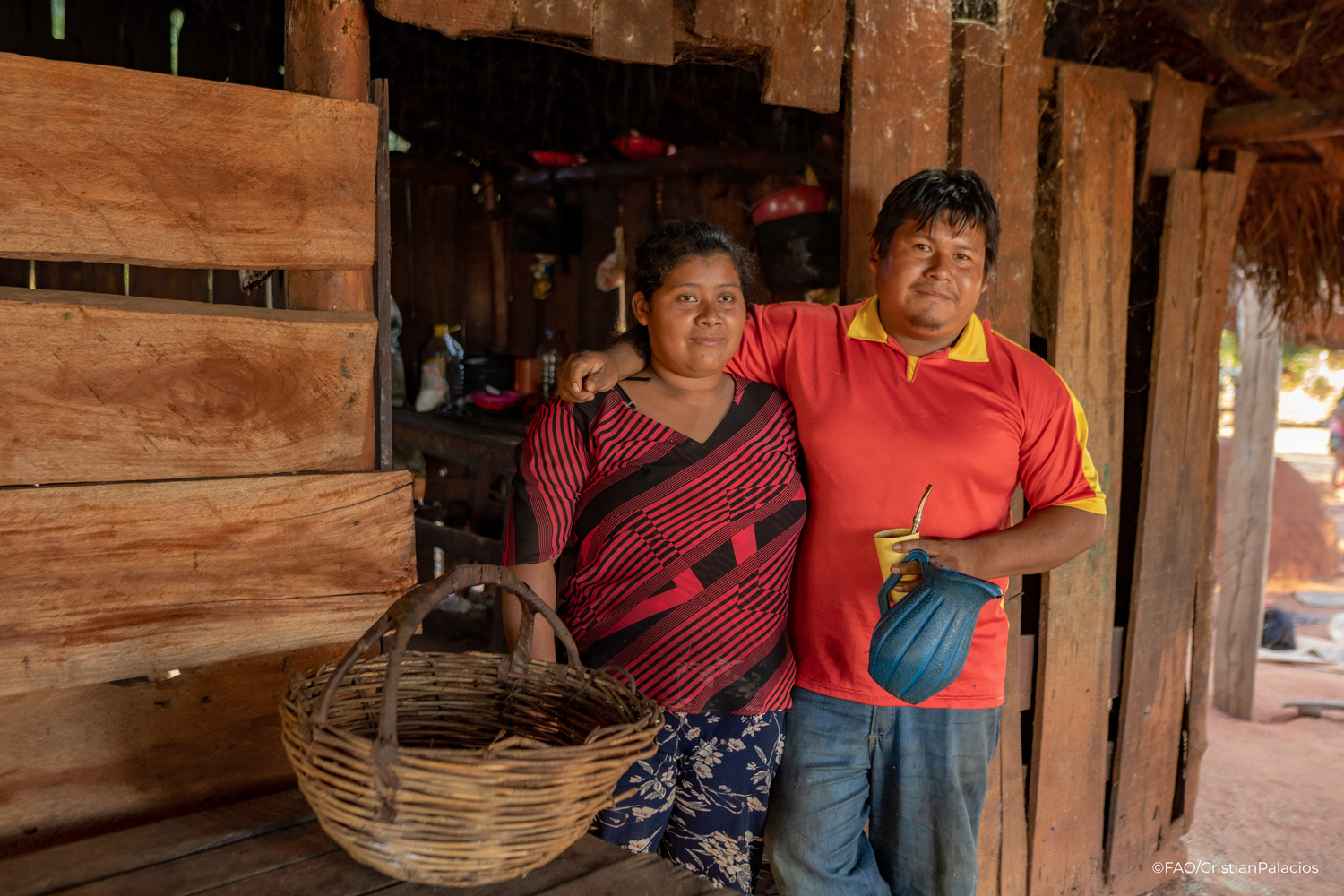
Sacred plant helps forge a climate-friendly future in Paraguay
Using ancestral knowledge and growing yerba mate trees to accelerate climate action
The Ava Guaraní Indigenous Peoples in eastern Paraguay have long harvested the leaves of the yerba mate tree to make a beloved caffeinated brew. With wild yerba mate trees increasingly scarce, this community, with FAO’s assistance, is planting new trees to support the environment and their livelihoods. ©FAO/Cristian Palacios
15/02/2024
For generations, Ariel Benitez's ancestors, the Ava Guaraní people, one of the Indigenous Peoples living in eastern Paraguay, have been harvesting the green leaves of the yerba mate tree to make the bitter, caffeinated brew beloved in South America and beyond. But what's changed is that the leaves they traditionally harvested in the wild have become increasingly scarce, partly as a result of climate change. So Ariel and his fellow members of the community, based in Ka'atymiri San Francisco, about 230 kilometres from the capital Asuncion, are now cultivating seedlings to grow the crop.
They've planted more than 1 500 of them in combination with several other species of native trees, which are important for both the local ecosystem and as traditional sources of food and medicines.
"They [the trees] are adapting and growing very well. You can tell that they are in a land that is familiar to them," says Ariel.
It's all part of the "Poverty, Reforestation, Energy and Climate Change" (PROEZA) project, implemented by the Government of Paraguay with the support of the Food and Agriculture Organization of the United Nations (FAO) and the Green Climate Fund (GCF).
Aiming to capture carbon, the project seeks to help reforest the region, increase Indigenous communities’ nutrition and boost their incomes. Families are given supplies, machinery and external technical assistance to help with the planting of the trees and caring for the crops.
For Ariel and his community of about 25 families, "yerba mate is a sacred plant used for our consumption and as a natural remedy," he explains. "When there are religious ceremonies, it is always present."
Now the leader of the community, Ariel had just been born when his family settled in the middle of 600 hectares of forest and yerbales (an area where mate is plentiful) in the Capiibary district of the department of San Pedro.
The community has long been replicating the ancestral techniques practised by the Ava Guaraní Indigenous Peoples since before the arrival of the Spanish in the country. These techniques, involving knowledge of the lunar cycles for pruning and harvesting, natural control of pests and diseases and soil conservation are both reliable and environmentally friendly.
The yerba mate seedlings, which were planted in May 2022, will be ready for harvesting from the fourth year onwards. Once they reach that stage, they can look forward to over 60 years of productivity, judging from experience elsewhere in the country. The average yield per hectare in Paraguay is 5 000 kilogram/hectare, generating an average gross income of USD 1 100 per hectare annually, a significant amount for the average family in this community.
Also importantly, grown together with other trees and under their shade, yerba mate is a valuable asset for conserving the native forest.


The forest provides the Indigenous community with food, medicine and livelihoods. Climate change and human activities are putting these forests at risk, however. The PROEZA project is seeking to reforest this area and implement sustainable forest-based activities to boost family incomes. ©FAO/Cristian Palacios
Nature’s supermarket
In countries with Guaraní influence, such as Paraguay, drinking infusions of yerba mate with hot or cold water is part of daily life. The plant, whose scientific name is Ilex paraguariensis, is increasingly being exported to countries around the world, where it is sold mainly as an energy-boosting tea.
But it's far from the only resource in Ariel's community. "The forest is our supermarket. It has everything we need: remedies, food, wild animals, fruit...," says Treli Gabriela Fernández, Ariel's partner. She adds that they feel strongly about protecting and strengthening the remaining forest with the help of traditional practices that have been passed down the generations and will be shared with the couple's four children, now aged between three and 12.
"Now, the heat and wind can be extreme, but we don't feel it so much because there is still a little bit of forest left," says Treli. "We regret climate change because the trees are disappearing."
From generating income opportunities and reducing greenhouse gas emissions to reviving forests and reinforcing spiritual practices, the PROEZA project delivers multiple environmental, economic and cultural benefits to the Indigenous Peoples and to nature.

The project is building on the ancestral knowledge and techniques of the Ava Guaraní Indigenous Peoples for harvesting crops in a sustainable and environmentally sound way that will protect the forest and its inhabitants into the future. ©FAO/Cristian Palacios
In the Ava Guaraní community of Ka'atymiri San Francisco, Indigenous women and men share agricultural tasks. They say that the most challenging times are those when not enough food is produced in certain cycles of the year or because of the impact of the weather. Responding to this need, the PROEZA project also promotes production of foods such as beans, maize, watermelons, melons and cassava for families’ own consumption and income generation.
Much remains to be done to increase the forest cover, including strengthening the enforcement of environmental legislation, but communities are starting to feel a positive impact from the project.
The Ka'atymiri San Francisco Indigenous community's success and ongoing efforts with yerba mate show how agriculture, combined with ancestral knowledge, can go hand in hand with nature to forge a path towards a more sustainable and climate-friendly future.
Related links
Learn more
- Website: FAO and the Green Climate Fund (GCF)
- Website: FAO country profile: Paraguay

